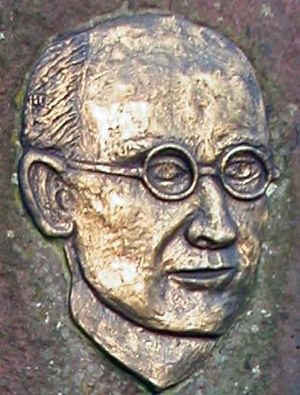Walter Hohmann facts for kids
Quick facts for kids
Walter Hohmann
|
|
|---|---|
 |
|
| Born | 18 March 1880 Hardheim, German Empire
|
| Died | 11 March 1945 (aged 64) Essen, Germany
|
| Nationality | German |
| Known for | Hohmann transfer orbit |
| Scientific career | |
| Fields | Engineer |
Walter Hohmann (born March 18, 1880 – died March 11, 1945) was a German engineer. He made a very important discovery about how spacecraft move in space. In 1925, he wrote a book explaining a special way to move a spacecraft between two different paths around a planet. This path uses the least amount of fuel. Today, we call this special path a Hohmann transfer orbit. He earned his Ph.D. degree from RWTH Aachen University in 1920.
Discovering Space Travel Paths
Walter Hohmann was born in Hardheim, Germany. His father was a doctor. For a while, Walter lived with his family in Port Elizabeth, South Africa, before they moved back to Germany. He studied civil engineering at the Technical University of Munich. He finished his studies in 1904. After that, he worked for city councils in different places like Vienna and Hanover. Later, he settled in Essen, where he became the chief architect for the city.
Walter became interested in space when he was a young boy. His father would show him the stars in the southern sky. When he read science fiction books by Jules Verne and Kurd Lasswitz, he started to wonder: "How do you get to space?"
Between 1911 and 1912, Walter was working as an engineer. His older cousin sent him some books about astronomy. Walter began to spend most of his free time studying the stars and planets. He started thinking seriously about how to travel between planets.
Walter soon realized that using less fuel would be very important for space travel. He drew many different paths for spacecraft. Finally, he found the path that now has his name. He wrote down his discoveries in a book called Die Erreichbarkeit der Himmelskörper. This means "The Attainability of the Celestial Bodies."
A Pioneer in Rocketry
Because of his important work, Walter Hohmann became a key person in Germany's amateur rocketry groups. This was in the late 1920s. One famous group was the Verein für Raumschiffahrt (VfR), which means "Spaceflight Society."
A writer named Willy Ley asked Walter to write for a book about space travel. The book was called "Die Möglichkeit der Weltraumfahrt," or "The Possibility of Space Travel." It was published in 1928. Walter wrote a section about "Routes, Timetables, and Landing Options." In this part, he suggested using a separate landing part to travel to the Moon. This idea was later used for the Apollo missions that went to the Moon.
After the Nazi party came to power, Walter Hohmann tried to stay away from rocket development. He did not want his work to be used for weapons. He passed away in a hospital in Essen in 1945. This was shortly before World War II ended. He died due to the stress from the war and the heavy bombing of the city.
Walter-Hohmann-Observatory
In 2009, the Walter-Hohmann-Observatory in Essen, Germany, put up a special plaque. It honors Walter Hohmann.
The plaque explains that Walter Hohmann was born to a doctor. He finished high school in Würzburg, Germany, in 1900. He studied engineering in Munich. From 1904, he worked as an engineer in different cities. From 1912, he worked as a city planner in Essen. He died there in a hospital on March 11, 1945. His special honorary grave is in Essen.
In his free time, Walter studied how things move in space. In 1920, he published his book, "The Attainability of the Celestial Bodies." He created important ideas and tools needed for space travel. His ideas were used for programs like the Apollo missions and the Voyager spacecraft. Today, he is known as a pioneer of space travel.
To honor his scientific work, a crater on the Moon was named after him in 1970. The Astronomical Association of Essen named itself the "Walter-Hohmann-Observatory" in 1971. Also, asteroid 9661 Hohmann is named after him.
See also
 In Spanish: Walter Hohmann para niños
In Spanish: Walter Hohmann para niños


